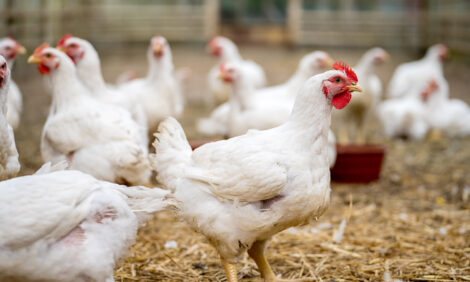



Effect of Holding Temperature, Shackling, Sex and Age on Broiler Breast Meat Quality
Temperature and handling before slaughter affected the colour and texture of the breast muscle in an experiment in Alberta, Canada, but researchers commented that the differences may not be significant commercially. Differences in the muscle quality attributable to gender of the bird may be more important than previously thought.Ante–mortem holding temperature and flapping can affect broiler pectoralis major (referred to as p. major) meat quality, according to B.L. Schneider of the Alberta Agriculture and Rural Development in Edmonton and co-authors there and at the University of Alberta in Canada.
In a paper published in Poultry Science, the researchers reported their findings on the influence of environmental temperature 12 to 14 hours before processing and ante–mortem handling on p. major functional properties and colour at multiple processing ages.
They used a 3×2×5 factorial design study. At 28, 35, 42, 49 and 56 days of age, mixed-sex broilers were crated and held in one of three target temperature treatments: heat (30°C), thermoneutral (21°) or cool (7°C). Following feed withdrawal, birds were transported to a processing facility where either a long (120 seconds) or short (under 10 seconds) shackling treatment was imposed. Sex was determined at processing.
Lightness, redness, and yellowness values were measured at deboning (4.50 to 8.25 hours post mortem) and at 24 hours post mortem. Ultimate pH was measured at 24 hours post mortem.
Drip loss, cook loss and Allo-Kramer shear force were determined at 72 hours post mortem.
The researchers found that ultimate pH was highest in the cool treatment, with no difference between heat and thermoneutral treatments (5.97 versus 5.87 and 5.90, respectively; P=0.0004). Ultimate pH correlated negatively with drip loss (r=-0.47; P<0.0001).
Drip loss was lowest in the cool treatment, with no difference between the heat and thermoneutral treatments (2.06 versus 2.24 and 2.19 per cent, respectively; P=0.007).
The p. major from broilers in the heat treatment had higher Allo–Kramer shear force values than those in both the thermoneutral and cool treatments (4.64 versus 4.21 and 4.21kg per gram, respectively; P=0.023).
With the exception of 49 days, broilers subjected to the long shackling treatment had higher redness values at deboning than broilers subjected to the short shackling treatment. By 24 hours post mortem, only the 28–day broilers subjected to the long shackling treatment had higher redness values.
Higher hue angles at deboning and 24 hours post mortem were observed in the short treatment compared with the long treatment (65.58 versus 57.46 and 68.48 vs. 63.31, respectively; P<0.0001), indicating that p. major from long-shackled broilers were redder in appearance.
Ultimate pH was lower in female broilers than in male broilers (5.87 versus 5.96, respectively; P<0.0001) and subsequent drip loss was higher in females than males (2.34 versus 1.99 per cent, respectively; P<0.0001).
Although temperature and handling before slaughter affected p. major color and texture traits, the differences may not be large enough to have commercial significance, according to Schneider and co-authors. They added that differences in p. major quality attributable to sex of the bird may have greater commercial significance than previously reported.
Reference
Schneider B.L., R.A. Renema, M. Betti, V.L. Carney and M.J. Zuidhof. 2012. Effect of holding temperature, shackling, sex, and age on broiler breast meat quality. Poult. Sci. 91(2):468-477. doi: 10.3382/ps.2010-00952
Further Reading
| - | You can view the full report (fee payable) by clicking here. |
March 2012









